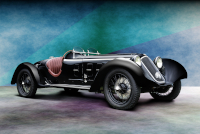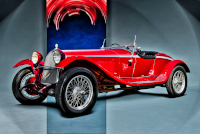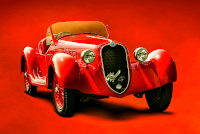Location:
Elegance at Hershey, 2015
Owner: Dennis P. Nicotra | New Haven, Connecticut
Prologue:
An odd starting point, we might hope to open the Alfa Romeo story with a profile more formally representative of the marque's roots. But the story itself contains so many left turns into experimental territory that, in the end, beginning with a design oddity is perfectly consistent with the best of the breed.
A car seen many times at auction, I didn't expect I'd like chassis #0312901 quite so much. But as soon as I began working with the images I found a lot to discuss. Perhaps the shape is crude, but we should appreciate the exaggerated lines that compose this little boat tail soapbox speedster; they are exuberant, fun, and fit for a car enjoyed by so many enthusiasts for so long.
- - - - - - - - - -
► Image Source: Nikon D750 (24.3 MP)
References:
- Automobile Quarterly, Volume 7, Number 2, "Alfa Romeo 6C 1750" by Michael Lorrimer, The Kutztown Publishing Company, Inc., Kutztown, PA, page 200
- d'Amico, Stefano. "Pure Alfa Romeo" Libri Illustrati Rizzoli, Milano, Italia. 2017, page 52
- RM Sotheby's: The updated story, part of the Monterey, 2021 auction.
- Bonhams: The auction listing from Greenwich, 2009 depicts the car in unrestored condition, with red paint and patina.
- Automotive Restorations Inc: Based in Stratford, Connecticut, they completed the restoration following the Greenwich sale.
- Gooding & Company: Their auction listing from Pebble Beach, 2014 marks the sale.
- UltimateCarPage: A little specification support for the Super Sport platform, by Wouter Melissen, February 25, 2015.
- Wikipedia: Good overview of the 6C family.
Chassis #0312901 is a 1¾-litre third series Super Sport, 1929 being the only year for the SS nomenclature. The Super Sport shares the same iron block and iron head motor as the Gran Sport of the following series. Lacking early documentation, we do not know whether #0312901 is an original Compressore, though the car acquired a supercharger early in life. Early retrofitting seems most likely, a common practice in those days among Alfa and Bugatti cars, though circumstances can be stranger than they appear at face value.
An oft-spoken sentiment on the subject, purportedly by Simon Moore (though I cannot verify), reads, "It should be remembered that fuel quality in Italy was rather poor at the time that these cars were new (at least outside the main cities) and this reason alone may have persuaded some customers to order the unsupercharged version just as there were some owners who did not wish to deal with the added maintenance that a supercharger required. Some probably distrusted the technology until it became more proven."
Today, the motor features a high-compression head and breathes through a period-correct, though perhaps non-original supercharger. The long-term South African owners noted that the supercharger threw a gear en route to a hill climb event in the 1960s, and was for some time replaced by a Marshall Godfrey unit, also known as a Marshall Cabin Blower; these were English-built superchargers designed for the aviation industry, though not unknown to the automotive world.
Original Oddity: Chassis #0312901 Coachwork
An unconventional way to kickstart any Alfa Romeo volume, chassis #0312901 wears a steel body of uncertain origin. When the car sold in 2009, Bonhams attributed the coachwork to an unknown English craftsman circa 1936. As of the car's later transit through RM Sotheby's, more recently discovered records place the car in Italy throughout the classic era, beginning with brothers Alfredo and Tito Nasturzio. The 6C does not leave Italy until 1939 with its ninth owner.
RM write, "Ownership then passed to Gianni Vallero of Durban, South Africa on 30 January 1939. Italian registration records end with a declaration of export on 30 May 1942, long after the car had sailed to the Southern Hemisphere."
In this case, the presumed date and origin of the coachwork move from 1936 near London, to 1938 near Savona.
RM further speculate that the coachwork could have come from Carlo Aprile (Aprile e Cavallo), who are also located in Savona. But to suggest the coachwork is "quite possibly" Aprile seems optimistic, as it is equally likely that the coachwork is an evocation inspired by Aprile.
Compared to the extraordinary 6C 1750 Aprile Corsa Spider (chassis #10814331), the coachwork depicted here lacks a sense of delicacy and strength of line. In the shorthand, the panels are wonky. In the balance, the concept Aprile penned features intricate detail and a completeness of thought more appropriate to the houses of Pinin Farina and Carrozzeria Touring. So it is possible to see how #0312901 might be an homage to the Aprile design based on the chassis' proximity to the genuine article, but it is difficult to speculate any further without evidence.
Post-War Itinerary: South Africa to America
Chassis #0312901 lives in South Africa for much of its post-War life under the stewardship of Dr. Hugh Gearing, beginning in 1950. As the Alfa's first long-term owner, (and eleventh overall), Dr. Gearing keeps the car well into the 1990s. And in 1992, Gearing lends the car to Juan Manuel Fangio for a few demonstration laps at the Kyalami circuit as part of a promotion sponsored by Pirelli.
RM share the recollection of Patrick Gearing, Hugh's son, "Good thing dad was racing the car at that time and it was fully prepared, because—albeit a demonstration—Fangio didn’t hang about. One of the car’s intrinsic memories for me is the smile on Fangio’s face when he clambered out and simply said to my dad: 'Bella macchina.'"
The car comes to the United States in November of 2012, where Automotive Restorations, Inc. of Stratford, Connecticut handles the restoration. The supercharger, however, goes to David L. George Historic Motorcars making chassis #0312901 yet another classic Alfa Romeo to receive support from this Cochranville, Pennsylvania shop.
In latter years, the car garners a wealth of attention—now widely photographed and well known. For not being representative of the classic 6C Super Sport shape, this chassis rather demonstrates the prevalence of peculiar one-off Alfa Romeo cars built during the classic era. The coachwork is an aberration, but certainly a piece of intrigue. And if these anecdotes are any indication, this 6C Alfa was driven con gusto for most of the 20th century.
Motor: 1,752 cc straight 6-cylinder, cast iron block, iron hemi-head | 65 mm x 88 mm | 5.0:1 compression | #0312901
Valvetrain: DOHC, 2 valves per cylinder
Aspiration: Memini DOA dual-choke carburetor, Roots-type supercharger
Power: 85 bhp at 4,500 rpm
Drivetrain: 4-speed gearbox, rear-wheel drive
Front Suspension: beam axle, semi-elliptic leaf springs, friction dampers
Rear Suspension: live axle, semi-elliptic leaf springs, friction dampers
Architecture: pressed steel ladder-frame chassis with steel body by an unknown panel-beater
Wheelbase: 2,745 mm (108.1 inches)
Top Speed: 145 km/h (90 mph)
Etymology:
'6C 1750' refers to the motor, a straight 6-cylinder of about 1.75 litre displacement. 'Super Sport' refers to the third series update of Alfa Romeo's Sport platform. With the addition of a roots supercharger, the Super Sport is the 1929 precursor of the fourth series Gran Sport, with roughly equal performance. We borrow 'spider' from the carriage trade, which refers to an open sports car.
Figures:
From 1929 to 1933, Alfa Romeo built a reported 2,579 examples of the 6C 1750, doing so in six different configurations over four successive development series. In truth, the 6C is a model split across the 6C 1500 (Series 1 and 2), and the 6C 1750 (Series 3 through 6).
Super Sport production figures vary, from as few as 50-some examples to perhaps more than 110, prior to the Gran Sport. The Registro Italiano Alfa Romeo (RIAR) suggest that in 1929 no fewer than 52 purchasers of 60 available 6C 1750 cars opted for the supercharged motor, meaning there would be more factory Super Sports than not. (But we do not know whether the car depicted here is a true factory-fitted Super Sport.) In any case, no 6C is quite like this one, with curious, unattributed English coachwork.
Value:
Chassis #0312901 sold without reserve at the Gooding & Company Pebble Beach auction in 2014 for $836,000.
More recently, chassis #0312901 sold at the RM Sotheby's Monterey auction in 2021 for $692,500.
Speedster Evocation: Custom Coachwork Crafted in Period
When the original owner looked at the elegant, Touring-inspired 8C Alfa and decided he wanted a version of that body on his early-model 6C, he clearly knew that a copy was out of the question. A design fit to the stature of the small-capacity sports car, given its own unique proportions would do. This situation is much like the aerodynamic Type 51 Bugatti that is patterned on Jean Bugatti's Type 57 Atlantic Electron, but in its own way, on its own scale. The major difference is that, in the case of this 6C Alfa, the owner most likely turned to local trade, rather than contract any of the renowned coachbuilders of the time.
A steel body with no visible craftsman's marks, (at least none publicized), the fit and finish speaks of enthusiasm, not provenence. But 'provenence' is a snooty word. The more I have looked over and worked with the shape, the more I appreciate the subtle cues that connect this design with its show car counterpart. And I appreciate diversity. So the execution matters much less to me than the pleasure of enjoying a unique car whose story, were it more conventional, would not brew so much interest.
At a glance, the early Alfa 8C design is classically pretty. But I wholly appreciate the linearity of this unique 6C. The concept diverts into entirely different territory, delivering a low aspect. Credit to one of most steeply raked grilles of the classic era, deep-cut cockpit openings, and minimized running boards—it is rather clever aerodynamic thinking that the builder pushed the limits in terms of how much the shape could be reduced. Credit to the Brooklands screens—it is English minimalism, paring down the notion of what is required for fast touring. Credit to the boattail hatch—it is a canoe in simple terms, which in Italian would have been a barchetta. Waste time lamenting provenence. A lot of decisions went right when it came to the ideas behind this design.
I do love the ornate fins on the bonnet vents, the simple, single chrome strip along the diminutive running board, and of course the twin Brooklands screens. The spade-shaped nose is dramatic on its own, and presents the Alfa grille in a way unlike any other car. Like a contemporary Riley or SS Jaguar might have done, the cowl wraps up and over the dashboard in a not-at-all simple set of curves and folds. And the body may not be any narrower than a standard 6C 1750 bodied by Zagato, but at a glance it certainly feels that it is.
Put Together: Asymmetric Panels on a Custom 6C 1750 Spider
Not to ignore the execution, chassis #0312901 has some extra character. To be clear, most classic era coachwork is slightly uneven, to some extent a sign of true hand-craftsmanship. This car is slightly farther out of whack. The front fenders, which do ape those of the early 8C 2900 car from head-on, look a bit askew, like a bow tie twisted a few degrees anti-clockwise. And the fenders are the real telltale, as all four seem to be slightly different shapes of slightly different heights. The left side skirts looks generally taller than those of the right. The unevenness probably aggravates those who are used to perfect concours restorations, but I think the point to remember is that this is period unevenness, and perfection on the concours scene can be (literally) over-rated.
This 6C Alfa is ostensibly an English barchetta special. In this spirit, viewed against the GN hillclimb specials and stubby Rileys and pickle baskets on wheels with bicycle-chain drive that came before, this car makes perfect sense. Viewed against Milanese Superleggera goddesses... a bit less so.
Color Choice: Changing Paint after 21st Century Restoration
Presumably titled in South Africa at the time, the Bonhams auction entry from 2009 shows the car in red, with unpainted wheels and a set of signals and what look to be either reflectors or small fog lights in the lower corners of the front skirts. Some period photos of the car show it in the same red finish, though earlier monochrome photos indicate the car was first painted black. Notes on the restoration do not say one way or another. But the car is black now and, whereas I normally prefer color, in this case I think black is better. The uninformed often say black is best because it accentuates lines; but it is quite the reverse. Black looks good because it hides lines. (Most any shape becomes adequate when painted black. White is the true test, because only a truly beautiful shape looks good in white.) For this 6C Alfa, black paint is a good choice because many of the lines are either asymmetric, misaligned, or both.
6C Motor: Layer Cake Details of the 6C 1750
Under the bonnet, the details glisten. My favorite detail is the set of cooling louvres just under the Memini carburetor. Though it is difficult to look beyond the beautifully cast, finned intake manifold, the finish on the crankcase sides shows a lovely patina. The plate on the crankcase and the plate on the side of the bulkhead both carry the #0312901 stamp. Overall, the multi-part crankcase, polished cylinder housing, finned intake, and shiny cam covers give the motor a layer cake finish, different ways of forming metal into different textures for different purposes. Like strata of 20th century technology, the motor's composition is both purposeful and beautiful.
Last Updated: Mar 26, 2025












